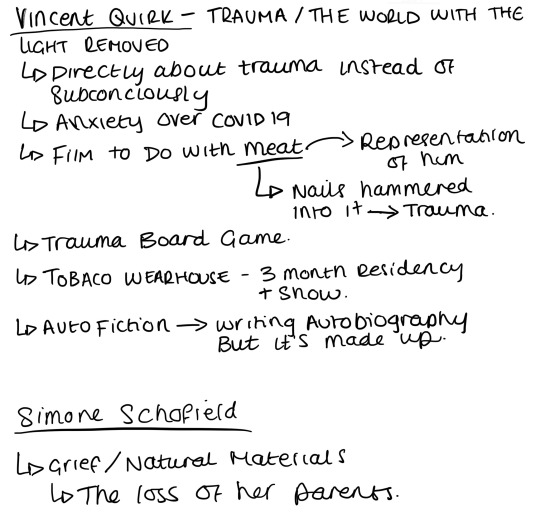Hello, this is my blog for University in which I discuss my opinions on the artists we speak to each week - as well as sharing some of my own work :) ENJOY!
Don't wanna be here? Send us removal request.
Text
Christiane Blattmann
Christiane explores architecture, urban design and fashion and sculptural practice. ‘The constant Glitch’ is an oven sculpture which depicts the warmth of the human body , as sculptures are typically cold. Her intention for this piece was to display the traditional conventions of what a sculpture is supposed to be which is typically a “body depicted three dimensionally in a space.” She uses the oven as a juxtaposition.
At first glance, this piece is not my favourite of hers because of its simple and vague structure, followed by the assumption that all sculptures are cold when quite often sculptures are made through the process of thermolipolysis. In my opinion, this piece lacks heavily in creativity compared to The Bug and Forever Tickled, which both represent how complex her work can be. I find the colour bleeds and intricate textural details mesmerising, making me wish that these pieces were physically wearable.
Materials and fabrics and ink bleeds are definitely something i would like to explore myself, however textiles is not something i am that familiar with. I find similarities between her work and mine through her abstract take on colour and shape.
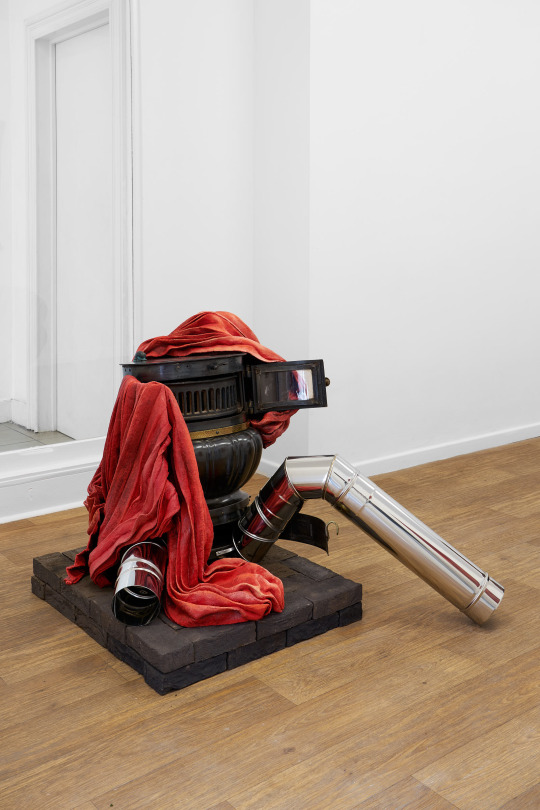
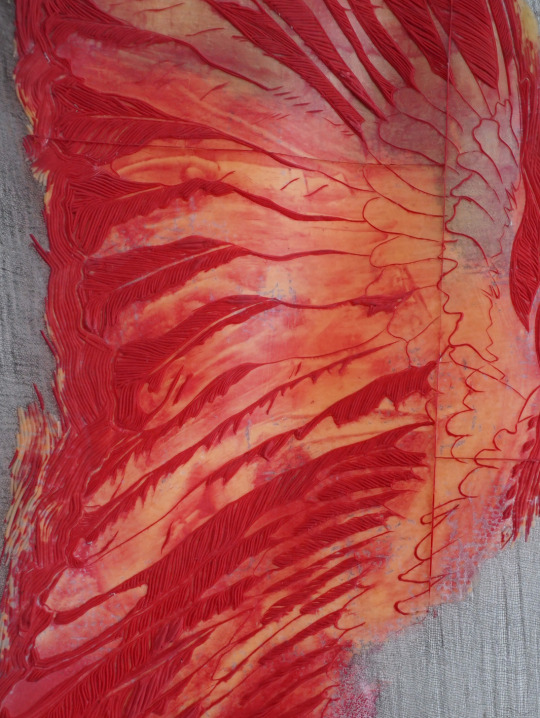

0 notes
Text
Rafael Lozano-Hemmer
Rafael Lozano-Hemmer is a Mexican-Canadian electronic artist who works with ideas from architecture, technological theatre and performance. Rafael reveals his fascination with the effects of death , covid , and only having access to the memory of our deceased loved ones. He explained the humbling feeling he got when experiencing COVID-19. The concept of death resonates with him and his Mexican heritage as death is something that is thought about a lot within Mexican culture. "A Crack in the Hourglass" is an installation /performance piece by Rafael which consists of a custom made robot that generates images of the deceased out of grains of sand. participants are able to virtually see these portraits of loved ones. Once the sand sculpted portrait has been completed, the robot will gently tilt the sand so that the image disappears , recycling it so that it can be used for the next portrait. There have been hundreds of portraits all used with the same small amount of sand.
I was blown away when reading about this piece. A memory is something so distant and invisible, yet somehow Rafael was able to reignite those memories for grieving families through the combination of art and science. I particularly love the way that the whole concept and execution of the concept closely resembles the traditional Mexican holiday, ‘The day of the dead.’ It makes me think of a 21st century take on the day of the dead picture alters that display images and belongings of deceased family members as a sign of respect.
I think His work relates to mine in the way that he thinks existentially about death, allowing that to feed into his practice. I do also try to redirect my worries into my art because it is the only thing that offers me a satisfying outlet.

0 notes
Text
Cecilia Vicuña
Cecilia Vicuna is a poet, activist, performance and visual artist. After watching her artist talk in 2019 i instantly became aware of her unique and bizarre approach to poetry. The beginning of her extract explores inaudible speech and strange mouth sounds which then leads to her speaking in Spanish and later introduces her story using English dialogue. Her words confront real life limitations contrasted by spirituality. She says, “The true performance is that of our species on Earth: the way we cause suffering to others, the way we warm the atmosphere or cause other species to disappear. I cover myself with clouds to feel like the Earth feels” I love this quote because of the way it tackles real world issues and references the connection that she feels that she has to the earth.
Her use of spoken poetry is something that resonates with me as i am currently planning an instillation piece that will confront similar issues to Cecilia Vicuna. The premise for the piece is going to be a sculpture that takes influences from Kara Walker’s ‘Fons Americanus’ piece , and will tackle some of mankind’s ugliest traits. This will be followed by an audio speech of some sort, or perhaps i will perform the speech in person as the audience views the statue. Cecilia Vicuna is someone who will influence the making of my poetry.
0 notes
Text

When looking at Anna Zacharoff’s work I am greeted with a clear sense of identity and complete certainty in who she wants to be as an artist. Her work isn’t performative in terms of wanting to appeal to an audience, and instead only appeals to her personal interests, expanding on her in depth knowledge of the sea world and the colours and forms that fascinate her the most. I believe this is because she has an urge to use painting as an outlet for her fascinations. From the wednesday lecture, her excitement over the subject matter was clear to see, which was positive and refreshing. It was nice to be faced with an artist who manages to capture nature in such a timid yet expressive way, like placing a magnifying glass over whole ecosystems that we have no access of looking into without disturbing them. She shines a light on the importance of our natural surroundings , and how vital it is for them to remain untouched and uninterrupted. I feel that there are correlations to my own work in a way, as I have previously looked at the meat industry and the trauma that humans inflict on animals, sea life, and the planet. I feel that animal representation in art is so important. We often forget that although our lives are important, so are the lives of the thousands of animal species that are rapidly becoming extinct because of our incompetence. I would like to continue my focus on female empowerment however, I would also like to address other social and political issues such as the importance of our planet and our animals.
0 notes
Text

Lara Almarcegui is a conceptual artist and focuses mainly on building materials and their eventual dereliction. She finds herself getting angry when walking through streets and seeing buildings constructed and decided by someone else. She likes to see what can’t be accessed in buildings. The parts that people don’t see. Her work deals with debris, destruction, and tons of materials which can equal a painstaking process. She does all the calculations for the amount of materials that’s needed herself.
What I like about her work is the way she confronts the physicalities of buildings and how she physically and metaphorically tears them down to reveal remains which can be interpreted in more than one way, like most art does, however the vast scale of these particular works add a layer of dedication that I can only relate to Phyllida Barlow’s massive sculptures that often threaten to topple over at any moment.
Relating Lara’s work to my own, my comfort practice tends to be painting, however I have always thoughts about making large scale sculptures, or even large scale paintings. I am used to doing huge mural commissions however they are usually decided by the customer and I just paint what they want. I am hoping to find opportunities in which I can paint whatever I want on to a large area.

0 notes
Text
Joanna Zielińska’s
Joanna Zielińska is an art historian, exhibition maker and performance curator.
I like the way Joanna uses an exhibition space to give a work its full potential. Her fascination with performative works reminds me of my own personal ideas which i hope to reflect in my work. I am currently working on music video and green screen which will be a new medium and a new way of working for me.

0 notes
Text
Pádraic E. Moore
Pádraic E. Moore is a writer, curator and art historian, currently living in Amsterdam and studied History of art in Dublin. he has organised many curatorial projects. He believes that visual art creates alternative interactions between people which is important because of the divide that this new technological world has created. He has acute awareness which is vital when organising another artists work as the presentation is often just as important as the work itself.
0 notes
Text
Rosa-Johan Uddoh
‘Rosa-Johan Uddoh is an interdisciplinary practitioner working towards radical self-love, inspired by Black feminist practice and writing.’
She is interested in British pop. culture, particularly black performance in pop culture. Her work also uses feminist methodologies which tie in with her intentions of working towards radical self love. Rosa - Johan Uddoh is acutely aware of how bodies are conditioned by space, which is reinforce by her various performance pieces.
Her performance piece ‘the masters tools will not dismantle the masters house’ was one that stood out to me. Each of her performances appropriate a particular popular media format, which also suggests intentions of using humour and parody to create postmodern performances. I really like this work because of the cultural references and the bizarre visual approach.
Her work relates to mine regarding our common interest in exploring feminism and pouring that into our work. I have recently painted a series depicting a woman’s menstrual cycle and the effects that it has on our bodies. These works involve light gore and humour, much like Rosa-Johan Uddoh’s work does.
I think no matter what topics i decide to study to influence my art, i will always return back to feminist methodologies.
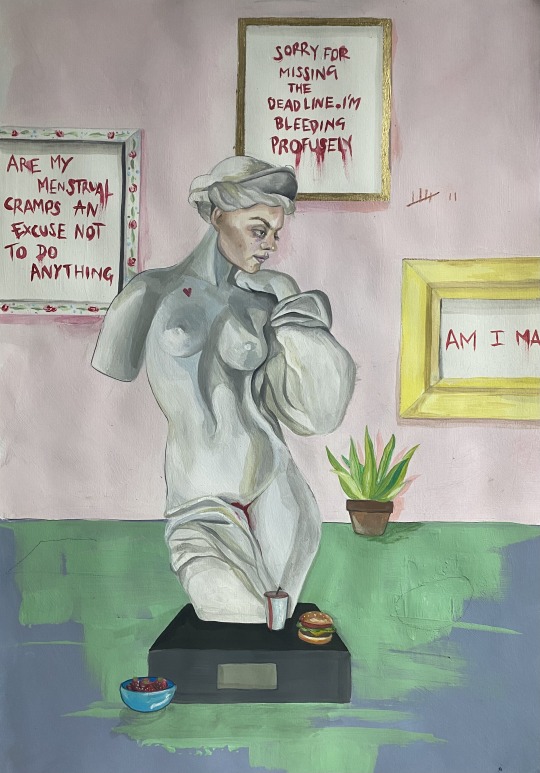

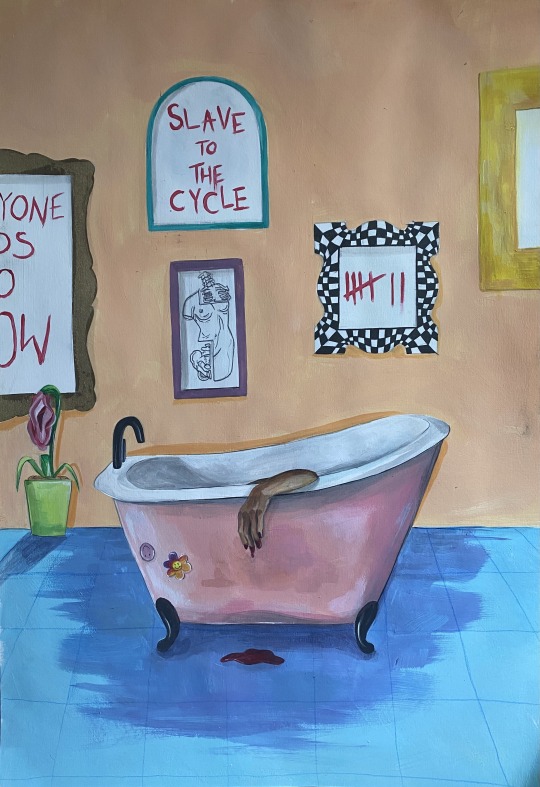
0 notes
Text
Yeşim Akdeniz
Yesim Akdeniz’s work concerns orientalism , gender, queer studies and cultural appropriation, she also primarily focuses on painting. her paintings are figurative and abstract and have been compared to Giorgio de Chirico.
she paints scenarios that are ‘calmly peculiar’, and compositions that aren’t familiar to everyday life. She composes fantastical and dreamlike images that incorporate modernist architecture, Hollywood icons, safari animals, women, men or household items. She is also commonly known for her use of symbolism. I really appreciate her subject matter, as i like political art that creates conversation and confusion.
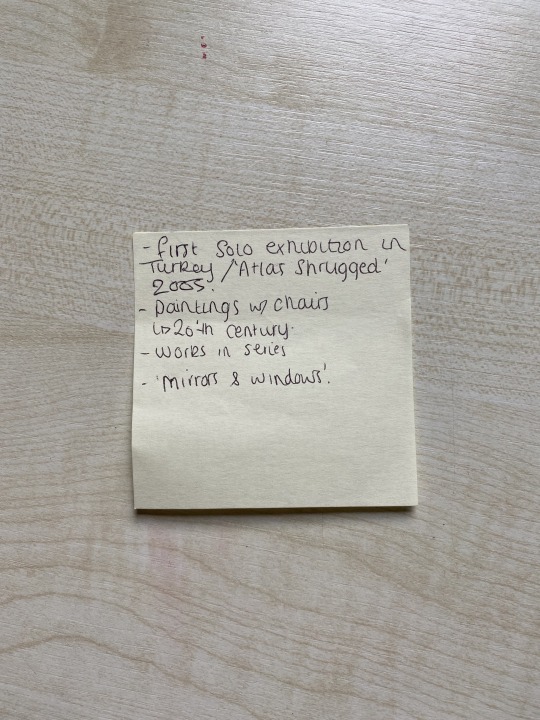
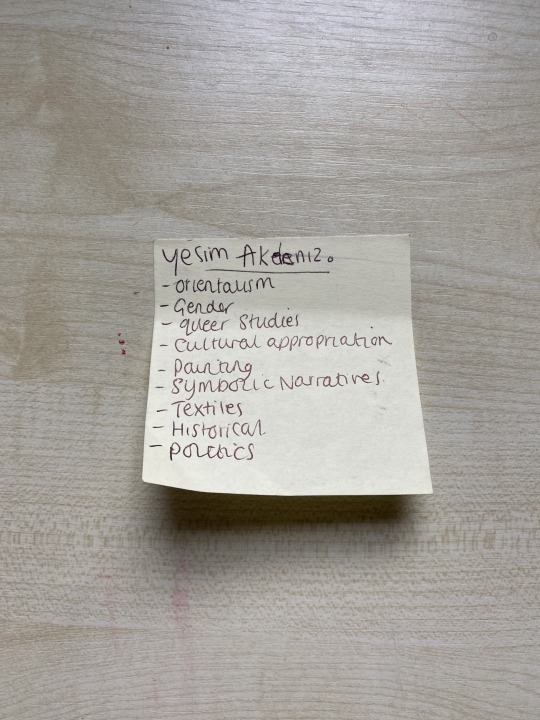


0 notes
Text
Amy Sillman
‘ Amy Sillman is an American painter. Her artistic practice also includes drawings, cartoons, collage, iPhone video, and zines.’
I have enjoyed looking at Amy Sillman’s process and experimentation as well as her analysis of what art making ( in her opinion ) should look like. I am fascinated by her cartoon like style and freedom with paint, and the curation of her exhibitions are equally as gripping, eg - printing essays about her work into books to sell at her exhibitions.

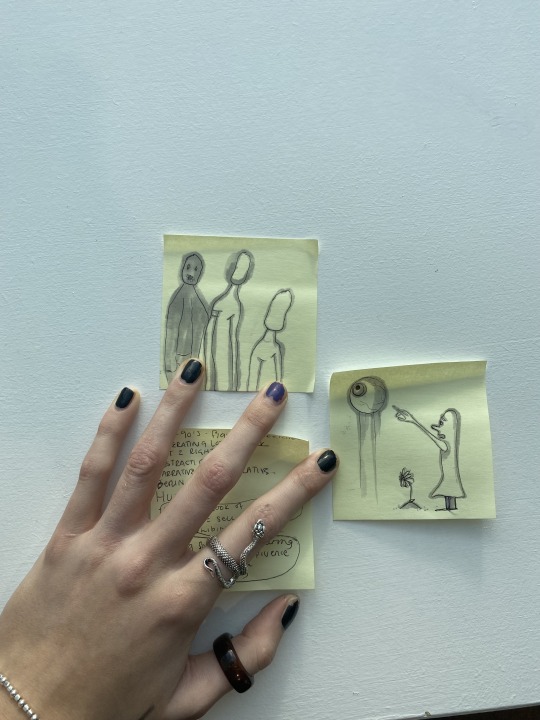
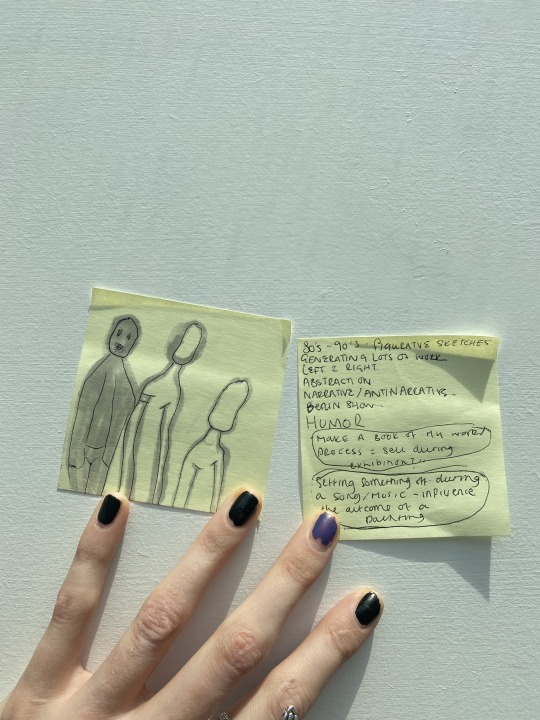
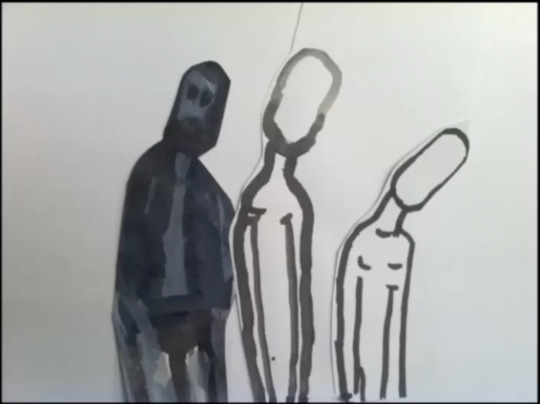
0 notes
Text
Hetain Patel
‘Patel is interested in connecting marginalised identities with the mainstream in effort to destabilise notions of authenticity and promote personal freedom.’
He specialises in performance, sculpture , video and photography, exploring pop culture references through a DIY lense. Some of his films go by the name of ‘American Boy 2014′ , ‘Don’t look at the finger 2017’ and ‘American Man 2016.’
An example of Patel’s videography is ‘American Man’ which uses humour and fantasy along side political issues to explore race and gender identity. In this fictional world, celebrity power has reached new heights, in which patel switches the roles of famous figures and personal freedom walks hand in hand with guilt. He creates a future where Obama is CEO of Apple, and steven Hawking is the voice for disney characters. He states “I wanted to imagine what it would be like if he became bad Obama, if he had his own YouTube channel and began to spout horrible things.” He finds pleasure in creating dystopian possibilities.
0 notes
Text
Mimi Hope
She grew up in a family environment very much involved in musical theatre which led to her love of set design. Her school focused on painting , specifically oil and acrylic painting, and rarely exposed students to the other forms of art such as sculpture etc.
After struggling to find a school that specialised in her interests , she began teaching herself a lot of what she knows through reading books. She began creating sculptures , one in particular conveyed the emotions of how it would feel to with the lottery.
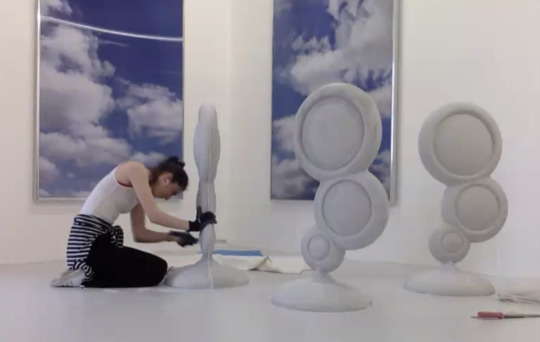
0 notes
Text
Rachel Whiteread - Ghosts in the room
In 1993 , the British sculptor Rachel whiteread became the first woman to win the Turner Prize. This led to her being celebrated across the world. She was also awarded the title of the best and worst artist in Britain.
Her chair sculptures represent an absence of audience as well as minimalism. She manages to make memory solid, by using childhood memories and turning them into physical things.
She painted in Brighton in her teenage years, however got bored with the edges of canvas and paper and wanted to go further physically, and stretch her ideas across a larger space

0 notes


